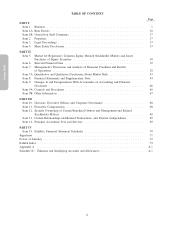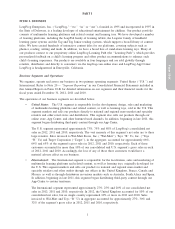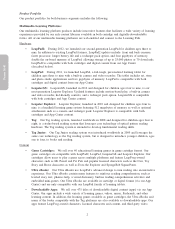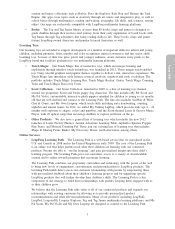LeapFrog 2012 Annual Report Download - page 18
Download and view the complete annual report
Please find page 18 of the 2012 LeapFrog annual report below. You can navigate through the pages in the report by either clicking on the pages listed below, or by using the keyword search tool below to find specific information within the annual report.
ITEM 1A. RISK FACTORS
Our business, financial condition and operating results can be affected by a number of factors, including those
described below, any one of which could cause our actual results to vary materially from recent results or
from our anticipated future results. In addition to other information contained in this Annual Report on
Form 10-K and our other filings with the SEC, the following risk factors should be considered carefully
before you decide whether to buy, hold or sell our common stock. Additional risks not presently known to us
or that we currently deem immaterial may also impair our business, financial conditions, results of operations
and stock price.
If global economic conditions deteriorate, our business and financial results could be affected.
We develop and distribute educational entertainment for children. Our performance is impacted by the level of
discretionary consumer spending. Consumers’ discretionary purchases of educational entertainment items for
children may be impacted by unemployment, foreclosures, bankruptcies, reduced access to credit, falling home
prices, lower consumer confidence and other macroeconomic factors that affect consumer spending behavior.
Uncertainty with respect to future government spending levels in the U.S. and related national debt matters,
along with lingering questions about the debt crisis in certain member states of the European Union, poses a
significant threat to the global economy as a whole. If these or other matters led to a deterioration of global
economic conditions, it could potentially have a material adverse effect on our business and operating results.
Our business depends on our ability to correctly predict highly changeable consumer preferences and
product trends.
We operate in an industry where consumer preferences can change drastically from year to year. Even our
successful products typically have a relatively short period of high demand followed by a decrease in demand
as the products mature. For example, net sales of the classic Leapster platform peaked in 2006 and are no
longer material to our overall sales. We depend on our ability to correctly identify changing consumer
sentiments well in advance and supply new products that respond to such changes on a timely basis. We also
rely on our ability to identify third-party entertainment media that is likely to be popular with consumers and
license rights to such media to incorporate into our products. In addition, we need to be able to accurately
forecast sales of these products in order to optimize our production schedules and manage our inventory.
Consumer preferences, particularly children’s preferences, are continually changing and are difficult to predict.
Since our products typically have a long development cycle, in some cases lasting over a year, it can be
difficult to correctly predict changing consumer preferences and accurately forecast optimal production and
sales targets for these products. If we are unable to correctly predict consumer preferences or successfully
integrate popular third-party media with our own, it would negatively impact our operating results.
To remain competitive and stimulate consumer demand, we must continue to develop new products and
services and successfully manage frequent product introductions and transitions.
Due to the highly volatile and competitive nature of the industries in which we compete, we must continually
introduce new products and services, enhance existing products and services, and effectively stimulate
customer demand for new and upgraded products. In 2011 and 2012, we introduced a number of new products
and services to the market that represented a substantial portion of our 2012 sales and, in some cases,
represented a significant change in the way we interact with consumers. For example, in 2011 we launched
the LeapFrog App Center, which allows consumers to download content for use with some of our products
directly from us instead of purchasing game cartridges from our retailers. In addition, some of the key
products launched in recent years, including our 2012 release of the LeapPad2 and associated content on our
App Center, have a high price point compared to other children’s products and apps. We cannot be sure that
any new products or services will be widely accepted and purchased by consumers or that we will be able to
successfully manage product introductions and transitions. Failure by consumers to accept our new products
and services or to pay a higher price for some of our key products, or our failure to manage product
introductions and transitions, could adversely affect our operating results.
10
























